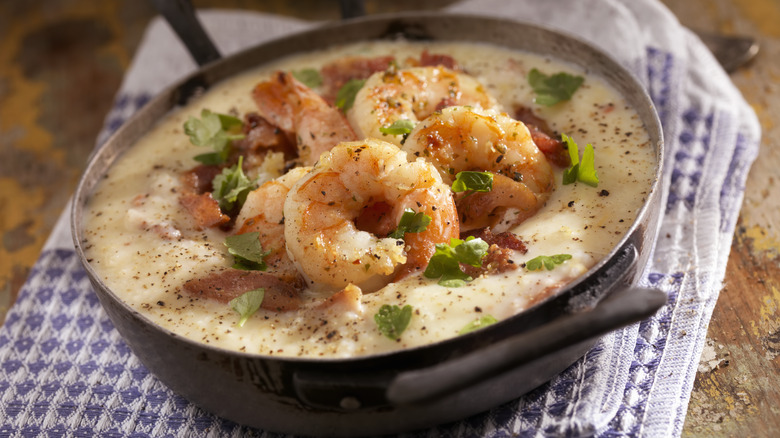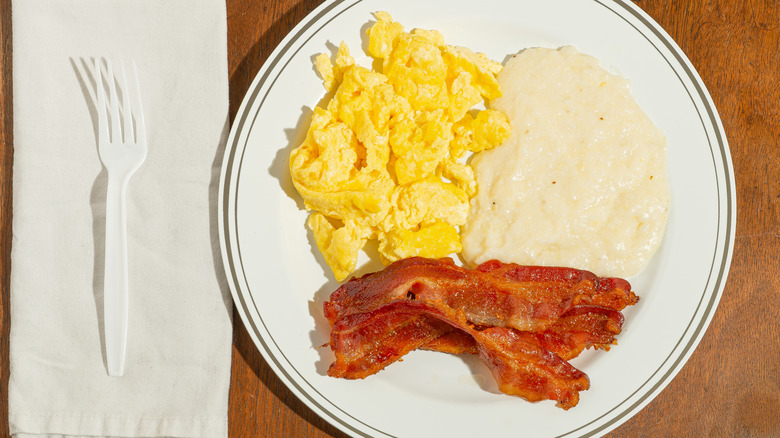For Unbeatable Southern Food, Hit Up The Grits Belt
You won't find what is known as the Grits Belt on any given map of the United States. It's not an official landmark — rather, it's a region. The Grits Belt is a trail of states running from Texas to Washington D.C., marking where most of America's grits are sold. While there is no distinct line indicating where it starts or ends, the Grits Belt divides the country into two parts: the areas where grits are exponentially enjoyed (and often available to order in eateries), and the areas where the buttery, ground corn dish is less commonly found on menus.
If you're in the Southeastern part of America, you're in the heart of the Grits Belt. In these states, you can expect not only to find grits, but some of the best Southern cuisine in general. Whether you stop at a roadside diner, a family member's kitchen, or a revered restaurant along its unofficial path, you're likely to encounter the beloved dish in some way, shape, or form. Whether they are served simply as a side with scientifically-delicious eggs and bacon for breakfast, or elevated to levels that fit on the menus of top-rated restaurants, finding grits won't be hard.
Grits are a symbol of the South
Before European settlers arrived in the Southeastern states of what would become the United States, grits were already a part of the diet of the area's Muskogee Native Americans. These tribes taught the settlers how to grind dried corn until the texture was small, coarse, and gritty, and then how to properly cook it to soften the texture. Filling, abundant, and affordable, grits became a staple food among settlers in the New World. Today, they are a common part of breakfast, lunch, and dinner in the South. Although they naturally have an underlying flavor of corn, plain grits are somewhat tasteless, which is why they are so adaptable to other flavorings and toppings.
While in the Grits Belt, expect to find dishes like chicken-fried steak, eggs, biscuits, and a side of grits with a pool of melted butter in the middle for breakfast. Lunch might be a bowl of ham and white cheddar grits. And while many in the South might balk at the mention of preparing grits with anything other than water, milk undoubtedly makes them richer. Many classic Southern dinners that you'd find in the Grits Belt include this corn staple, like shrimp and grits, fried pork chops or chicken with grits on the side, and country ham slices over a pool of bacon-flecked grits. Think of it this way: In the Belt, grits are essentially the equivalent of the potato side dish up north. They simply come with everything.
Cook your grits with care
The Grits Belt may not be a marked path as you travel across the South, but when you start to see that classic corn side dish at every stop you make, you'll know you're there. Of course, if you're an out-of-towner and fall in love with grits (as many do), you can always make them at home. However, as simple as grits may seem, perfecting them can be challenging.
In grocery stores, you'll find several types of grits: instant, quick-cook, and regular (or old-fashioned). Stone-ground grits, which are coarser, most closely resemble what the early Native Americans and settlers would have prepared. These are typically found in specialty shops.
Regular grits take about ten minutes to cook fully; quick grits cook in half the time because they are ground finer. Instant grits are already fully cooked and then dehydrated. Regular grits usually require a one-to-four grit-to-liquid ratio, meaning four cups of water, milk, or stock for one cup of grits. The secret to achieving creamy and smooth grits is to cook them on low heat for an extended period. If they're not cooked long enough, the ground corn will remain tough and gritty. Grits can become lumpy if not stirred consistently, so it's important to whisk them as you add them to your liquid, and continue whisking during cooking.



